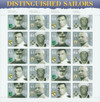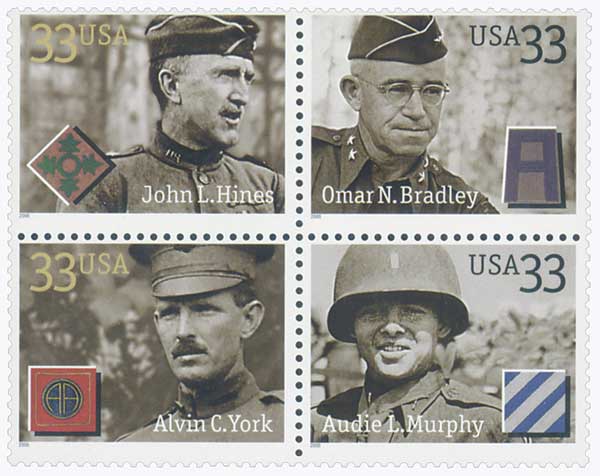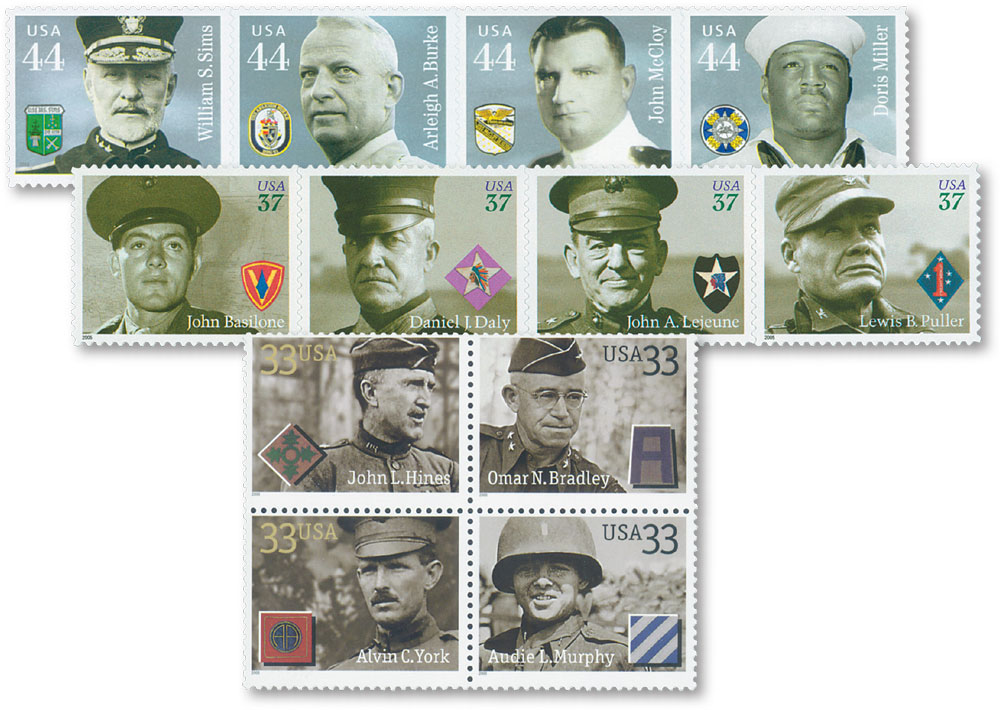
# 4440-43 - 2010 44c Distinguished Sailors
Please note: Due to the layout of the pane, the se-tenant may or may not be provided in Scott Catalogue order.
Distinguished Servicemen Series
The USPS developed these stamps to honor not just these four World War I and World War II veterans, but all soldiers. While the USPS admitted they couldn’t honor every US serviceman, these stamps were a tribute to all of them.
In speaking about the stamps, the chairman of the Postal Service Board of Governors said that “The Postal Service takes great pride honoring four courageous Americans with the issuance of these stamps… I know that these four men hold a special place in the hearts of many Americans. It is a fitting tribute that their dedication and bravery will forever be remembered on US postage stamps.”
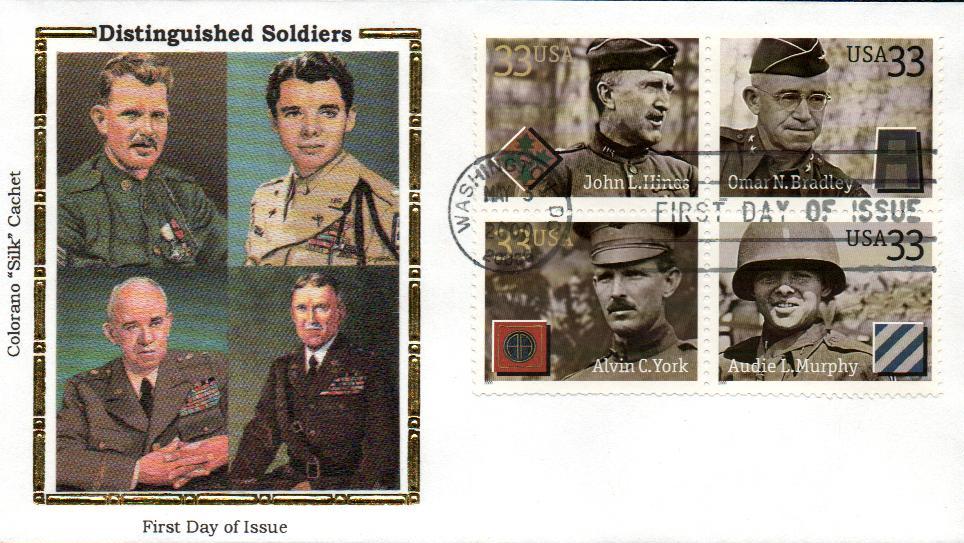
The stamps were first made available for sale on May 3, 2000, in a special ceremony in Washington, DC. Among those present were Secretary of the Army Louis Caldera and family members of the four men featured on the stamps. Each stamp features a black and white portrait as well as the shoulder sleeve insignia of the units in which they served.
These stamps honored John L. Hines, Omar Bradley, Alvin York, and Audie Murphy. During World War I, Hines successively commanded a regiment, brigade, division, and corps in combat. Prior to Hines, the last leader to accomplish such a feat was Lt. Gen. Thomas “Stonewall” Jackson, during the Civil War. Omar commanded the largest US battle force ever (1 million men). Bradley was one of the most-respected wartime commanders because of his leadership qualities and concern for the troops.
York was a World War I hero who single-handedly attacked a German machine gun emplacement. He captured 132 prisoners. Murphy was the most decorated US combat soldier of World War II. In one instance, he used a tank’s machine gun to stop an enemy attack and saved his unit and himself.

Five years later, the USPS issued the Distinguished Marines stamps on November 10, 2005. In announcing these stamps, the USPS said they were the first US stamps to depict individual Marines. The men selected were chosen because the USPS believed they “best represented the spirit and tradition of the Marine Corps.”
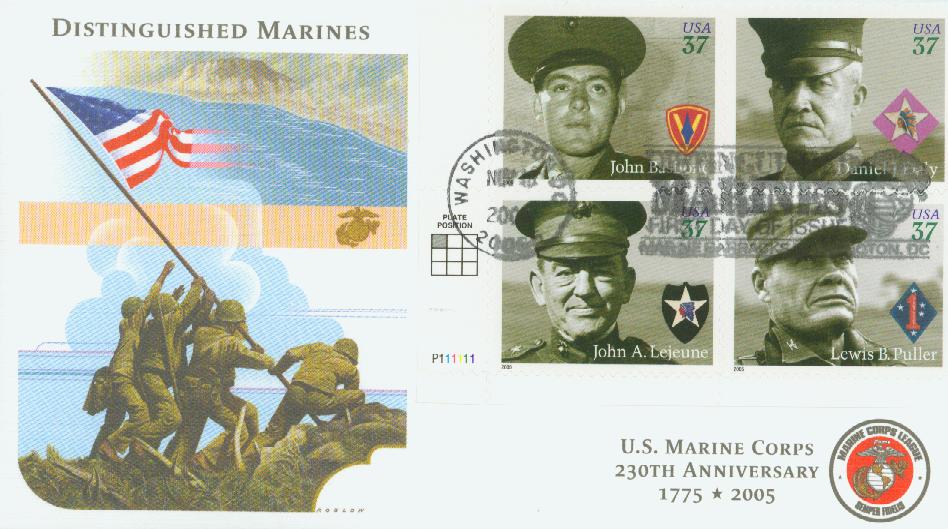
John A. Lejeune served with the Marines for more than 40 years and was the first Marine general to command an Army division. Lewis B. Puller earned five Navy Crosses during his career and was the most decorated man in Marine Corps history. John Basilone earned a Medal of Honor for his bravery at Guadalcanal and later died after single-handedly destroying a Japanese blockhouse on Iwo Jima. Daniel J. Daly received the Medal of Honor for his role in the Mexican-American War in 1914 and was once called the “outstanding Marine of all time.”

The third issue in the Distinguished Servicemen Series was released on February 4, 2010, at the US Navy Memorial in Washington, DC. In speaking about the stamps, the postmaster general said, “These brave individuals represent the US Navy’s proud legacy of service to this nation. Their example is an inspiration to every American.”
Admiral William Sims was noted for developing tactics that defined Navy strategy for decades, including aircraft carrier strategies years before the first carriers were even built. Arleigh Burke established US dominance on the high seas during World War II and the Korean War, earning three Navy Crosses, two Navy Distinguished Service Medals, and the Presidential Medal of Freedom.
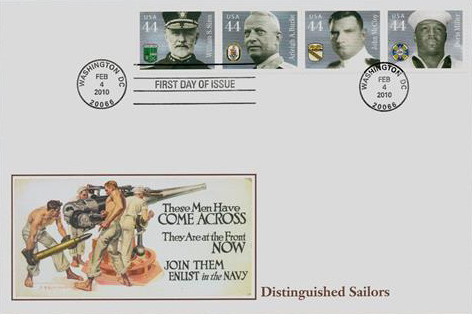
John McCloy demonstrated valor during China’s Boxer Rebellion while protecting the US embassy, and during the invasion of Vera Cruz during US intervention in the Mexican Revolution. And Doris Miller earned a Navy Cross for his role in the attack on Pearl Harbor, during which he rescued wounded sailors and shot down Japanese planes.
Please note: Due to the layout of the pane, the se-tenant may or may not be provided in Scott Catalogue order.
Distinguished Servicemen Series
The USPS developed these stamps to honor not just these four World War I and World War II veterans, but all soldiers. While the USPS admitted they couldn’t honor every US serviceman, these stamps were a tribute to all of them.
In speaking about the stamps, the chairman of the Postal Service Board of Governors said that “The Postal Service takes great pride honoring four courageous Americans with the issuance of these stamps… I know that these four men hold a special place in the hearts of many Americans. It is a fitting tribute that their dedication and bravery will forever be remembered on US postage stamps.”

The stamps were first made available for sale on May 3, 2000, in a special ceremony in Washington, DC. Among those present were Secretary of the Army Louis Caldera and family members of the four men featured on the stamps. Each stamp features a black and white portrait as well as the shoulder sleeve insignia of the units in which they served.
These stamps honored John L. Hines, Omar Bradley, Alvin York, and Audie Murphy. During World War I, Hines successively commanded a regiment, brigade, division, and corps in combat. Prior to Hines, the last leader to accomplish such a feat was Lt. Gen. Thomas “Stonewall” Jackson, during the Civil War. Omar commanded the largest US battle force ever (1 million men). Bradley was one of the most-respected wartime commanders because of his leadership qualities and concern for the troops.
York was a World War I hero who single-handedly attacked a German machine gun emplacement. He captured 132 prisoners. Murphy was the most decorated US combat soldier of World War II. In one instance, he used a tank’s machine gun to stop an enemy attack and saved his unit and himself.

Five years later, the USPS issued the Distinguished Marines stamps on November 10, 2005. In announcing these stamps, the USPS said they were the first US stamps to depict individual Marines. The men selected were chosen because the USPS believed they “best represented the spirit and tradition of the Marine Corps.”

John A. Lejeune served with the Marines for more than 40 years and was the first Marine general to command an Army division. Lewis B. Puller earned five Navy Crosses during his career and was the most decorated man in Marine Corps history. John Basilone earned a Medal of Honor for his bravery at Guadalcanal and later died after single-handedly destroying a Japanese blockhouse on Iwo Jima. Daniel J. Daly received the Medal of Honor for his role in the Mexican-American War in 1914 and was once called the “outstanding Marine of all time.”

The third issue in the Distinguished Servicemen Series was released on February 4, 2010, at the US Navy Memorial in Washington, DC. In speaking about the stamps, the postmaster general said, “These brave individuals represent the US Navy’s proud legacy of service to this nation. Their example is an inspiration to every American.”
Admiral William Sims was noted for developing tactics that defined Navy strategy for decades, including aircraft carrier strategies years before the first carriers were even built. Arleigh Burke established US dominance on the high seas during World War II and the Korean War, earning three Navy Crosses, two Navy Distinguished Service Medals, and the Presidential Medal of Freedom.

John McCloy demonstrated valor during China’s Boxer Rebellion while protecting the US embassy, and during the invasion of Vera Cruz during US intervention in the Mexican Revolution. And Doris Miller earned a Navy Cross for his role in the attack on Pearl Harbor, during which he rescued wounded sailors and shot down Japanese planes.








